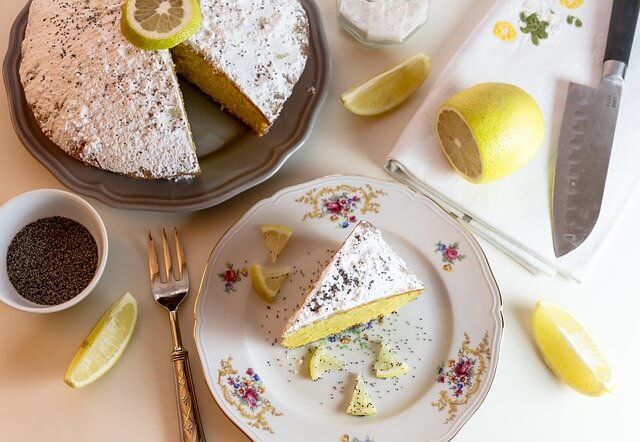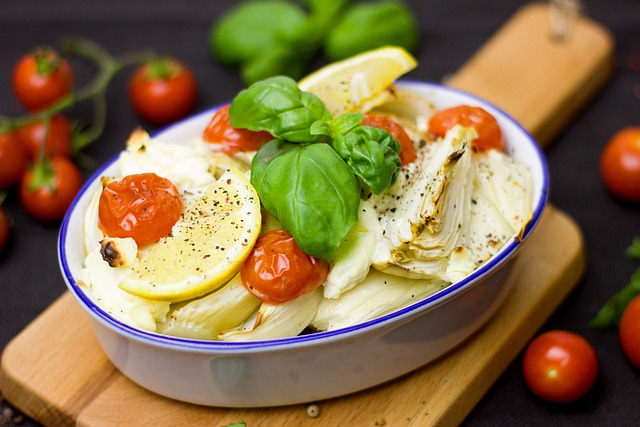These lemon cookies are vegan, taste incredibly fluffy and light. The preparation is child’s play! Be sure to try it!
More about these delicious vegan lemon cookies
A recipe that doesn’t bother you: cookies can be eaten at any time of the day or night.
Cookies are more than just the English name for biscuits. They describe an American, palm-sized type of biscuit that has a crunchy edge and a soft center.
The best of both worlds for those with a sweet tooth!
And whether as a quick breakfast, a sweet snack in between or with a good, strong cup of Darjeeling – vegan lemon cookies are the perfect combination of sweet biscuit and summer-fresh lemon.
In addition, they are quickly made and baked if the afternoon coffee drinking arises spontaneously.
Basic recipe for vegan lemon cookies
For about 30 pieces
- 250g vegan margarine
- 200 grams of sugar
- 100 grams of brown sugar
- 1 packet of vanilla sugar
- 1 banana
- 400 grams of flour
- 1 teaspoon baking powder
- 1 tsp baking soda
- 1 unwaxed lemon (peel)
- 1 pinch of salt
Bake lemon cookies:
- Mix the margarine, sugar, salt and vanilla sugar with the banana to a creamy mass.
- Sift in the flour, baking powder and baking soda and mix with a hand mixer to form a dough. Depending on the margarine, this works better with a whisk attachment or a dough hook.
- Line a baking tray with parchment paper and use a tablespoon to place 9 mounds of dough on it. Make sure you leave enough space, the cookies will spread out over a wide area while baking. If you want to be on the safe side, only spoon up 6 mounds of dough.
- Bake on the middle rack for 10 minutes at 150 degrees (convection oven). When the cookies are done, they should still have a soft center with a delicate golden tint and a golden-brown caramel color around the edges.
- Let the cookies cool on a wire rack and repeat until the batter is used up. Lukewarm cookies are great with tea and coffee, but they need to be completely cool to decorate.
Note: You can also buy the grated lemon zest ready-made, but you can mix colorful summer cocktails with the grated lemon!



Sour makes fun – variants for lemon cookies
The great thing about cookies is that they can be combined with other flavors to your heart’s content. Not only does this give an individual touch, but the light color of the lemon cookies acts like a white canvas and therefore allows other colors to shine brightly.
Lemon cookies with fruits, nuts and chocolate are very popular:
With vegan white chocolate
In addition to the basic recipe you need:
50g vegan white chocolate
Of course, other types of vegan chocolate also go well with lemon cookies, but vegan white chocolate in particular harmonizes perfectly with the color of the dough.
There are also many possible combinations: you can grate the chocolate and stir it directly into the dough, or you can chop it roughly or buy it as a chocolate chip and sprinkle it on the dough just before baking.
And if you fancy something special: Take the cookies out of the oven just before the end of baking, grate white chocolate generously over the surface and then continue baking for 2 minutes. So you have a slightly melted, textured decoration on the surface and a great taste in the biscuit!
With macadamia nuts
In addition to the basic recipe you need:
30g macadamia nuts
Macadamia nuts come from Australia and if anyone needs refreshment in the hot season, it has to be the Australian continent! A combination with a wink!
For the amount of dough in the basic recipe, chop one nut for every two lemon cookies. You decide how big the pieces are.
Then, just before baking, sprinkle the pieces on the mounds of dough and press them very lightly into the dough with a spoon.
By the way, you can use this variant 1:1 for your favorite nut!
With raspberries
In addition to the basic recipe you need:
100g frozen raspberries
Note: Fresh raspberries are not well suited for baking cookies as they are not surrounded by batter and therefore quickly become mushy. Frozen raspberries are third and therefore much better for biscuits.
Press the piles of dough flatter onto the baking sheet and top them with the raspberries. This shortens the baking time by about 2 minutes, but decide this based on the coloring of the biscuits.
You can also combine raspberries with nuts or white chocolate! For this, only take half of the specified amounts.
With orange instead of lemon
If you don’t like lemon, you can also replace the zest 1:1 with grated orange zest. This takes some of the acidity out of the taste and replaces it with the juicy taste of the orange.
Here, of course, it makes sense to decorate the cookies with candied orange slices!
Basic knowledge for vegan baking
Baking vegan is far less complicated than many people think. Because a lot of it is based on the principle: Baking with existing ingredients instead of additional purchases.
The vegan bakery does not only focus on the issue of animal welfare. It is based on the values of sustainability, climate protection and fair trade. Very often, vegan products are also manufactured under ecological aspects: with electricity from renewable energies, products from regional or ecological cultivation and short distribution channels.
Vegan products also often have a longer shelf life or are more suitable for storage than animal products and therefore produce significantly less food waste.
As an additional side effect, the vegan bakery also accommodates some common food allergies. Many people with a pronounced lactose intolerance live vegan because they can be sure that their products do not contain any traces of dairy products.
Baking vegan is therefore more than doing without animal products .
Ingredients for our vegan lemon cookies
- 200g protein flour (alternatively wholemeal flour)
- 1 tsp cornstarch
- 1/2 teaspoon baking powder
- 120g vegan butter
- 80g xucker or sugar
- 2 tsp almond butter
- 2 tea spoons grated lemon zest
- 4 tablespoons squeezed lemon juice
- 1/2 teaspoon vanilla extract
- For the glaze:
- 30g sugar or sugar
- 4 tablespoons squeezed lemon juice
Preparation:
Mix butter and sugar in a bowl.
Add lemon zest, cornstarch, vanilla extract, almond butter, lemon juice, and baking powder.
Pre heat the oven to 180 degrees celcius.
Shape the dough into small biscuits and place on the baking sheet.
Bake for about 10-12 minutes.
Let cool completely, spread with icing or icing and enjoy.
What can I replace in vegan baking and how?
The biggest differences in vegan baking are dairy and eggs. While there are already very good vegan alternatives to dairy products, the consistency of which is very similar to that of animal products, the egg substitute often depends on the recipe.
All in all, with vegan baking even more than with vegan cooking, it is important to ensure that the consistency of the dough changes as little as possible. Otherwise the baking times and temperatures will no longer be right and the result will not be as tasty as hoped.
With a little practice, however, vegan baking is easy to do.
replace dairy products
The first thing to do is always to use vegan substitutes: plant-based milk, soy quark, plant-based oil or vegan margarine.
They only make up a marginal difference in consistency in the dough and are often available in “ready-to-bake” sizes, so they don’t produce any excess to be processed.
Things are different with oil: vegetable oil can be a great substitute for butter, but provides significantly more liquid. In addition, care must be taken to ensure that the taste is as neutral as possible – nobody wants tart olive oil in the cake!
However, it is particularly useful if this liquid is missing for other products, such as a very dry egg substitute. It can also be found in every supermarket, which is not always the case with vegan margarine.
Because with vegan margarine, you always have to pay attention to the labeling as a vegan product, since some manufacturers use the addition of dairy products for the taste or the spreadability.
replace egg
You can now buy vegan egg powder in many supermarkets. This is tailored to a perfect egg substitute and provides precise instructions on how many grams of powder you replace an egg with.
It is therefore great for checking the consistency of the dough – but it should not be purchased separately for a one-time use in baking, as it is only needed for vegan cuisine. If you often want to cook and bake vegan, it is an absolute recommendation.
There are also many alternatives, but the consistency of the dough must always be taken into account. Especially when the recipe calls for more than two eggs, alternatives should be combined to balance liquid and dry into an egg-like mixture.
bananas
Bananas bind dough very well and are therefore always worth considering. At the same time, they sweeten with and inferior pastries with their own taste – that can be a blessing or a curse. So think about whether banana flavor fits into the pastry.
Ratio: 1 egg = 1/2 banana
applesauce
Applesauce is more tasteless and liquid than banana. It doesn’t set very well so shouldn’t replace more than 2 eggs, but makes for great airiness in cakes.
Ratio: 1 egg = 1 tbsp apple sauce
Aquafaba
Aquafaba is chickpea water. It comes very close to the consistency of egg white and can be whipped into an egg white-like mass. However, there is some taste of its own in the pastry. You should also have a use for the chickpeas to avoid wasting food.
Ratio: 1 egg = 2 tbsp aquafaba.
Strength
Starch binds dough extremely well and is therefore often combined with a liquid egg substitute. It has no taste of its own and can be found in practically every kitchen.
Ratio: 1 egg = 2 tbsp starch
Chia seeds
Chia seeds are not only a high-fiber superfood on their own, but also help very well as an egg substitute in the dough consistency. They are also often used for vegan pudding.
You need to let chia seeds soak for at least a few minutes before using, preferably overnight. To do this, add 2 tablespoons of water to every 1 tablespoon of chia seeds.
Ratio: 1 egg = 1-2 tbsp chia seeds (measured while not wanted)
Vegan lemon cookie decorating ideas
The eye eats with you!
And especially on the large, wide cookies you can let your creativity run free. Whether with frosting, 3-D figures made of fondant or food coloring: each baking tray is a new collection of potential works of art!
Vegan glaze ideas
In the classic way, vegan lemon cookies can be covered with a glaze made of powdered sugar and lemon juice. This particularly emphasizes the sour taste.
Vegan white chocolate also looks great on the cookies. You can either spread both icings over a large area, dip the cookies in half or paint random patterns with a spoonful or a brush stroke.
Powdered sugar icing or white chocolate is also ideal for colorful cookies using vegan food coloring. These are made from berries or vegetables and are labeled as vegan.
Attention: In the supermarket you will find colors that are of animal origin. Such as E120, also known as carmine or cochineal, which is obtained from scale insects.
Of course, you can also simply color your icing yourself by replacing some of the lemon juice with colored puree, juice or other coloring material. Raspberry puree gives you a delicate pink colour, crushed blueberries a rich dark blue and a pinch of turmeric a bright yellow.
Allow at least 30 minutes for the glaze to dry.
You can now place fondant pictures on this foundation, apply scatter decorations or distribute vegan chocolate flakes.
Vegan fondant
Fondant sometimes contains animal gelatin and is colored with food coloring. You should therefore pay particular attention to the vegan labeling or use marzipan instead of fondant.
Fondant is not a good icing for cookies because it won’t stick well to the surface unless you heat it up. On a colorful powdered sugar icing, however, you can stick wonderful small pictures.
Grab the Christmas cookie cutters and get creative! How about a blueberry blue icing with little yellow fondant stars as bedtime cookies? Or white flowers on a raspberry pink background for a garden party?
Sugar Sprinkles & Other Sprinkle Decorations
Here, too, caution is called for with food coloring. The vegan alternatives are now available in all colors and shapes, so that you don’t have to do without anything here either.
Colorful sprinkles look best on a white glaze. But unusual combinations also set visual accents, such as white sugar balls on dark blue icing or gold leaf flakes on a sunny yellow background.
chocolate shavings
Vegan chocolate is as easy to work with as milk chocolate and can be grated or chopped. It also needs glue on the surface of the lemon cookie, so it’s the only decoration that’s best applied right after baking.
Spread the cookies to be cooled on the wire rack and grate or sprinkle the vegan chocolate directly over them. This way they melt very little and therefore stick, but keep the structure you want.
You can also sprinkle some coconut flakes on white chocolate flakes. They stick well in the chocolate, but don’t melt themselves.
Enjoy your meal!
Tip: Have a look at dear Vivien , together with her I organized aLIVE BAKINGfor these delicious lemon cookies.
Did you like the vegan lemon cookie recipe ?
I really appreciate your feedback on this recipe here in the comments. Be sure to tag me on Instagram with your cooked pictures. I’m really happy about that! I would always like to know how you succeeded with my recipe and how you liked it.
You are also welcome to save my recipe pictures on Pinterest and use them later or even repin them.
Are you still interested in more salad recipes? Try the tomato onion salad or the mixed salad with fresh herbs !










